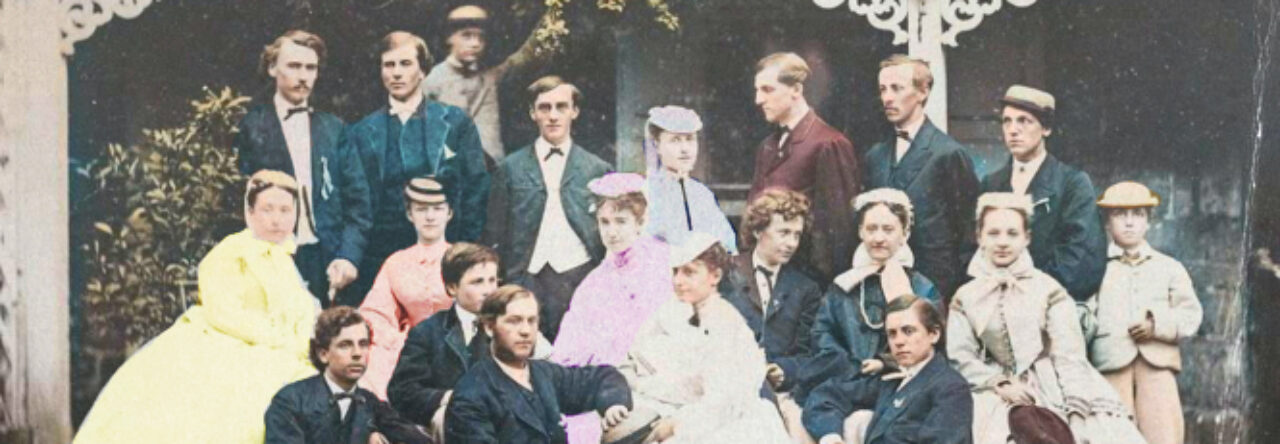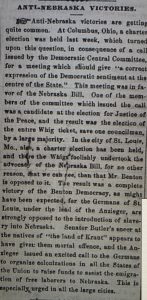“Geoff, I need help”. I stared at the foreign microfilm machine with dismay. I had been standing in front of it for what felt like ten minutes, trying and trying to figure out the right way to set it up. I finally decided the best way to get the machine working would be to call my trustee friend Geoff, a fellow member of my History 204 class.
“Ethan it’s just not that hard, just put the film…” After a longer explanation than I would like to admit, Geoff finally walked me through the process of setting up the film. I was ready to get started.
The goal of my research was to find 19th century newspaper articles of or pertaining to my graduating class (1854), and find anything relevant. I figured the best way to find out information on people, places, or events from around the Carlisle area in 1854 was the Carlisle Herald, the weekly newspaper that covered the area during my time period. The only way to read copies of this newspaper was on microfilm.
The most important part of this type of research (microfilm, that is) is to understand that it isn’t anything like doing research in an archive or online. There’s no “command f” like there is on the computer to easily find a reference to a word or subject. There’s no easy way to go to Google and find information on whatever it is you want researched. It’s all up to you to decide where to look, when to look, how to look, and then ultimately, find what it is you’re looking for.
To start, you have to have a specific timeline. If you’re going into a microfilm session with just an abstract idea in your head, you’re going to fail. To start your research, it’s imperative to know a date to begin. Then comes finding the right reel, which is easy once you have a time period.
Look at all those reels- if you don’t go in knowing what time period you want to study (which for our purpose was easy, seeing as we were assigned a specific class), it’s going to be impossible to find any information.
Once you have the right reel, then comes what I found to be the hardest part- loading the physical reel. After fifteen minutes of anger, a very unhelpful Circulation Desk worker, and my phone call to Geoff, I was away and reading the Herald from 1854. Of course, it took a few more minutes of scrolling to get to the right date, overshooting the date I was looking for, scrolling back, overshooting again, scrolling back, overshooting again, etc. You get the idea. Finally, after five minutes, I had gotten to the beginning of 1854. What I found was slightly discouraging.
I expected the Carlisle Herald, a newspaper about a town I had thought was heavily based around Dickinson College, to have articles galore about the happenings of the college. Maybe I’m particularly terrible at reading through microfilm or there genuinely wasn’t very much on the college, but after hours of reading dozens and dozens of newspaper articles, I only found two references. Both were in successive newspapers, one describing the new endowment, the other detailing the commencement ceremony of the Class of 1854. With my original research topic stemming around education, neither of these helped my research all that much (despite being interesting finds). It was fun to see the names of people I had researched previously turning up in another source, but in terms of furthering my research on education, these two articles weren’t too helpful.
I turned my search elsewhere in the Herald.
I found that most of the interesting topics came from the second page, the political section. It was fun to follow along on the process of legislation being passed in Pennsylvania, as well as commentary on Congressional legislation. I read all about the different opinions being voiced about the so-called “Nebraska Act”, an act that proposed making Nebraska a slave territory. Following the progression of the case through an 1854 newspaper was surprisingly entertaining.
I also found out that Pennsylvania successfully passed a Prohibition law in 1854. Usually when we study history, we learn about the outcomes and the events themselves, but here, I was following along knowing nothing about the outcome- as if I was living in the moment.
This is the beauty of researching through microfilm and newspapers. Reading these articles from 1854 transported me back in time, as if I was living in 1854 and getting all of my information from the same source that someone in Carlisle back then would have, the Herald. Reading the Wikipedia article on the Kansas-Nebraska Act (as it soon became known as, as opposed to just the Nebraska Act) wouldn’t have been nearly as exciting as following the week to week coverage in a newspaper from the time. This is what I found to be the most rewarding aspect of my time with microfilm. It didn’t necessarily aid me in my research topic or tell me much about Dickinson in 1854, but it did provide entertainment through following along with the same news story over the course of months.
Now, this isn’t to say that reading these newspapers was all fun and entertaining. For every article about the Nebraska Act or the Prohibition Act, there were five articles about things like the best use for lime.
Definitely important journalism.
This is another important thing to realize before using microfilm. There’s a distinct possibility that you don’t find exactly what you’re looking for. When you Google something, you know that within a matter of seconds, exactly what you want is going to pop up and you’ll easily be able to access the desired information. With microfilm, you could be reading for hours and not find a single piece of information relevant to your research. However, this doesn’t mean that you’re time has been wasted. Reading newspapers gives you a context for the times that you can’t get anywhere else. Being able to see how people thought, the events going on both nationally and locally, even what jobs were being offered and the posted advertisements, it all culminates in an experience that helps place the reader in the time period. I felt as though I was living in 1854.
After I was through with microfilm, I figured I had enough articles. However, I had this feeling of emptiness, of disappointment. I hadn’t exactly helped my research. It may have been a fun experience and I was intrigued following along with the news stories, but for my own selfish reasons, I was angry that I hadn’t found anything that helped me. To further my research, I turned to online databases.
My first step was to go to the Dickinson College Library website and find a list of databases that are offered to us as students. One of these was the American Periodicals Series 1740-1900. I figured this was the perfect place to look. I typed in “dickinson college” as my key term, narrowed the search window to just 1854, and was immediately overwhelmed by the amount of articles that popped up. One in particular caught my eye, an article entitled “Dickinson College, Educational Collections”. The article itself is a letter from President Collins (president of Dickinson in 1854) asking for donations from preachers and their congregations, as Dickinson serves to promote Christian education. This falls in line with the previous research I had done, which served to paint Dickinson as a school with good Christian values. Where my time with microfilm had been largely unimportant in furthering my research on 19th century education, using online databases was immediately impactful.
This is the biggest difference between microfilm and online research. I had a much greater sense of accomplishment using microfilm and had a more enjoyable time doing that type of research, but in terms of practicality, nothing beats the internet. Now, the Herald hasn’t been digitalized, so I had to use microfilm for that, but compare the results I got between microfilm and online research. Microfilm, I poured over those papers for hours and found two mentions of the college. Online, I poured over the databases for five minutes and found thousands of results, including one that directly aids my research topic.
If I could go back and change my methods for finding newspaper articles? Absolutely not. Using microfilm for the first time was a great experience. It made me feel like a true historian, going back in time to read what the Carlisle residents would have read in 1854. The sense of accomplishment and enjoyment I got out of seeing “Dickinson College” after hours of reading coupled with the entertainment I got following along on week to week news stories was so much better than anything I’ve ever done online. Microfilm may seem tedious, but everything has a purpose, and everything about it is enjoyable.






